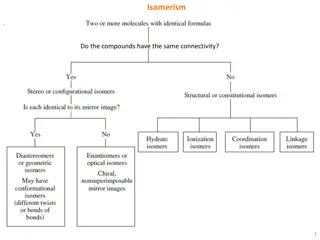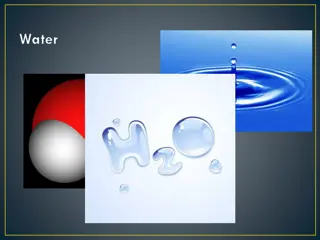Understanding Buffers in Chemistry
Buffers play a crucial role in maintaining stable pH levels in solutions. They are composed of a weak acid and its conjugate base or a weak base and its conjugate acid. This summary covers the definition of buffers, differentiation between buffer and non-buffer systems, the behavior of buffers when strong acids or bases are added, and the importance of pH indicators in understanding buffer solutions.
Download Presentation

Please find below an Image/Link to download the presentation.
The content on the website is provided AS IS for your information and personal use only. It may not be sold, licensed, or shared on other websites without obtaining consent from the author. Download presentation by click this link. If you encounter any issues during the download, it is possible that the publisher has removed the file from their server.
E N D
Presentation Transcript
Lab.6 Done By: Assistant Lecturer Zeina Dawood Assistant Lecturer Sura Zuhair Assistant Lecturer Hiba Sabah
Buffers: are compounds or mixtures of compounds that, by their presence in solution, resist changes in pH upon the addition of small quantities of acid or alkali. buffer action : The resistance to a change in pH .
What is a Buffer? A combination of a weak acid and its conjugate base (i.e., its salt) or a weak base and its conjugateacid .
Consider a buffer solution that includes of a weak acid and its salt such as the acetate buffer: H3O++ CH3COO CH3COOH (incomplete dissociation) (complete dissociation) CH3COOK K++ CH3COO
How can you differentiate between buffer system & non-buffer system? If 1ml of 0.1 N HCl solution is added to 100ml of pure water the pH is reduced from 7 to 3. When strong acid is added to 0.01 M solution containing equal quantities of acetic acid & sodium acetate the pH change only by 0.09 units bec. The base AC ties up the H ion according to the following equation AC + H O HAC + H O
To illustrate the way that buffer resist pH change lets take acetate buffer as example: HAC + H O AC + H O NaAC AC + Na if strong acid added H O shifts the equation to the left so ties up the H O ion. If strong base added OH shifts the equation to the right so ties up OH ion .
When a strong base, such as KOH is added, the following occurs: KOH OH + K+ CH3COOH H3O++ CH3COO (shifts to the right) CH3COOK K++ CH3COO The added OH ions react with the H3O+ ions to form H2O The decrease in [H3O+] causes a shift to the right and more CH3COO is formed.
pH- indicators the pH of the buffer solution can be measured by: 1- Colorimetric method: a)chemical indicator b) paper indicators 2- Electrometric method (pH meter).
pH Indicators Colorimetric method (chemical indicator): may be considered as weak acids or weak bases that act like buffers and also exhibit color changes as their degree of dissociation varies with pH. For example, methyl red shows its full alkaline color, yellow, at a pH of about 6 and its full acid color, red, at about pH 3.
Range and Color Changes of Some Common Acid-Base Indicators pH Scale 1 2 3 4 5 6 7 8 9 10 11 12 13 14 Indicators Methyl orange red 3.1 4.4 yellow Methyl red red 4.4 6.2 yellow Bromthymol blue yellow 6.2 7.6 blue Neutral red red 6.8 8.0 yellow Phenolphthalein colorless 8.0 10.0 red colorless beyond 13.0 Bromthymol blue indicator would be used in titrating a strong acid with a strong base. Phenolpthalein indicator would be used in titrating a weak acid with a strong base. Methyl orange indicator would be used in titrating a strong acid with a weak base.
The colour of an indicator is a function of the pH of the solution. The dissociation of an acidic indicator is given in simplified form as:
HIn is the un-ionized form of the indicator, which gives the acid color, and In- is the ionized form, which produces the basic color. If an acid is added to a solution of the indicator, the hydrogen ion concentration term on the right-hand side of equation is increased, and the ionization is repressed by the common ion effect. The indicator is then predominantly in the form of HIn, the acid color.
If base is added, [H3O+] is reduced by reaction of the acid with the base, reaction proceeds to the right, yielding more ionized indicator In-, and the base color is predominate. Several indicators can be combined to yield so-called universal indicators just as buffers can be mixed to cover a wide pH range(1-12) . Example of universal indicator is a mixture of methyl yellow, methyl red, bromothymol blue ,thymol blue & phenolphthalein which covers PH range 1-11.
H+ Phenolphthalein Indicator Colorless = Acidic pH Pink = Basic pH
B : small increment in gram equivalents/Liter of strong(base ) added to the buffer soln. to produce a pH change of pH
Factors affecting on buffer capacity:- 1- value of the ratio salt / acid increasing as the value approaches unity . 2-the magnitude of individual conc. of the buffer component , the buffer becoming more efficient as the salt & acid conc. Increased bec. of greater acid & alkaline reserve. 3- depends on the amount of strong base added , with addition of more base buffer capacity decreases rapidly& when sufficient base is added the acid converts completely to sodium & acetate ions, the solution is no longer act as acid reserve.( i.e. max. before any base is added )
Various buffer systems have been suggested for different pharmaceutical solutions: Sorensen phosphate Acetate buffer
Experimental work Part l: prepare 0.2 M HAC, ( solution A) 0.2 M NaAC (Solution B) 0.1 M NaOH.
Part III measuring the pH, using pH meter: Put the electrode of the pH meter in the buffer solution & read the pH. Take a certain volume of acetate buffer solution; add 0.0004 M sodium hydroxide portions (0.1 ml of 0.1 M) to it. Then, measure the pH and calculate the buffer capacity.

















































